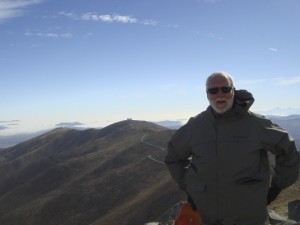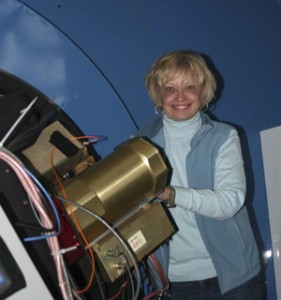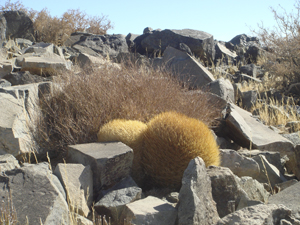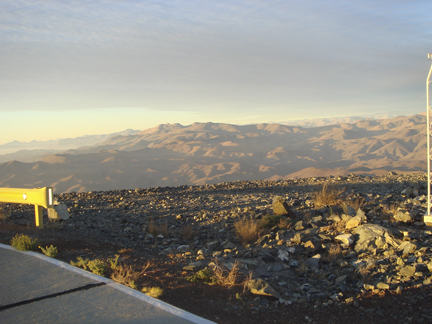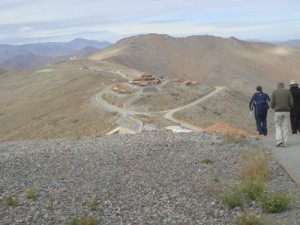On the Road in Chile: The Secretary’s travel journals
Day Four, May 27. Las Campanas. Weather—chilly and blustery, but spectacularly clear
Our last official duty at Las Campanas before we depart is to visit the proposed site for the Giant Magellan Telescope. Located on top of the Las Campanas peak, it is a relatively short drive from base camp. While the winds are blowing strongly at base camp, they are gusting at Las Campanas on this winter day. It is good to have on multiple layers and Anne and I mentally thank our friend Cristián Samper, director of the Natural History Museum, for reminding us to bring gloves! The site is strewn with large boulders of dense igneous rock. Miguel Roth demonstrates why this peak is named for Las Campanas or “the bells.” He picks up a fist-size black rock and strikes it against a larger one. Surprisingly, the rocks ring together with a delightful bell-like tone.
The views from the peak are spectacular and in the distance, the Magellan telescopes stand prominently on a ridge top. The peak was chosen for the GMT after careful consideration of the characteristics needed for a world-class observatory. It provides proximity to the other telescopes and the support capabilities of Las Campanas, and it offers excellent observing capabilities in terms of the number of clear days, the lack of light from urban areas, an elevation that is high, but not too high, and minimal interference from water vapor. Finally, the country of Chile has traditionally been supportive of astronomy and is helping its universities develop their own astronomy programs. Having access to the Las Campanas telescopes is a major advantage for Chilean universities.
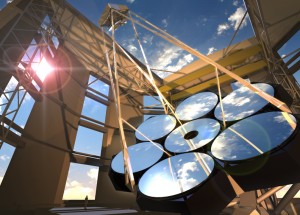
Artist’s rendering of the Giant Magellan Telescope. (Artwork by Todd Mason, courtesy of Carnegie Observatories)
On our return to the base camp, we prepare for our departure, appreciative of having been able to experience something special. Miguel and his fellow Las Campanas staff have been remarkably hospitable and Wendy Freedman and Dick Meserve have made sure our time has been filled with learning. Andrea Dupree has given us special insights into her research and explained why the Magellan telescopes are so crucial to her work and that of many other Smithsonian scientists. Above all, being in the company of so many dedicated scientists, having the opportunity to see firsthand how big-telescope work is done, and experiencing the remote and beautiful wilderness of the Las Campanas region with its remarkable starry skies is memorable.
In the afternoon we board the bus for the winding return to La Serena. We conclude the day with a wonderful dinner with our companions, those who are traveling and those who make La Serena home.
Day Three, May 26. Las Campanas. Morning, weather brisk and breezy. Light clouds.
Day begins with a trip to the twin Magellan telescopes. The mirror for each telescope is 6.5 meters in diameter and is housed in a framing system that is a mechanical marvel. The foundation for each of them was created by digging a hole 30 feet in diameter and 30 feet deep. This provides a base that will avoid vibrations and firmly support the framing system. The frame itself contains mechanisms that move the mirror smoothly in spite of its heavy weight. There are mechanisms beneath the mirror that allow its shape to be adjusted to account for the effects of its own weight on the mirror itself. Lessons learned from the Magellan telescopes will be put to good use with the 8-meter Giant Magellan Telescope mirrors.
Toward the end of our visit, Andrea Dupree, a senior astrophysicist at the Smithsonian Astrophysical Observatory (and a very helpful contributing editor on this journal entry!), took me up the ladder on the side of the telescope so I could see her favorite instrument on the Magellan telescope—a spectrograph (named MIKE) that breaks starlight up into colors that reveal physical conditions in the star itself and its surroundings. Andrea uses the information to detect winds and material lost from the youngest and oldest objects in our galaxy—including stars in the old cluster Omega Centauri. This helps us to understand the life history of the stars themselves and provides information about stellar evolution. Andrea’s enthusiasm is evident—she obviously loves her life work!
After our tour of the Magellan facility, we go off schedule for a few hours for lunch and time to explore the site on our own. Later in the day we will review the GMT partnership and the status of the project, followed by an opportunity at night for us to actually view the stars using the Magellan telescope.
For my time off, I decide to explore the trails around the site to look for wildlife and take in the dramatic scenery. In the course of my walk, I see a beautiful hawk soaring in the valley below. The hawk has a strong resemblance to the Red-Tailed Hawk seen in the southeastern United States, but it has a white breast with a white tail. Walking around a bend in the road, I come upon three wild burros grazing on the hillside. They seem well fed, and my presence does not spook them. Later I learn they may have become acclimated to humans because they get a few handouts from the cooks at Las Campanas.
My exploration turns up other small mammals and birds that live among the rocks in the hills and valleys. Vegetation, what there is of it, is of the prickly variety, which I assume is meant to deter predators as much as possible given this harsh environment. One shrub stands out. It is about a foot and a half high, light brown and round with a flat top. From a distance it appears to be formed from a tightly patterned weaving of stems. On closer examination, I find the stems are composed of a dense configuration of two- to three-inch-long sharp thorns. Upon my return to camp I asked our very helpful host, Miguel Roth, director of the Las Campanas Observatory, what kind of plant this is. He said he did not know the technical name, but it is locally called the “mother in law” seat. Enough said.
Walking back to the lodge I pass by the parking area in front of it and notice a sign, “Parking—Astronomers.” Where else in the world would parking spaces be set aside exclusively for astronomers?
At the meeting about the GMT, we review the progress of the partnership. An impressive group has signed up, including the Smithsonian, to build this new telescope. It will allow humans to view deep into space and time and explore the origins of the universe in ways never before possible. The GMT will allow imaging of newly discovered planets that are smaller than the earth. New concepts of “dark matter,” which forms more than 80 percent of the mass of the universe, will be developed. Work on the project is proceeding on all fronts and the first of the large mirrors has been built at a special facility that lies under the football field of the University of Arizona. The Smithsonian will need to raise significant funding over the next decade to meet its share of the cost, but the concept has been approved by our Board of Regents and we are committed to it to insure that our long-standing strength in astrophysics and astronomy is not diminished.
Later that evening we have a dinner with the observatory technical staff who run the telescopes and the facilities. This is not only a fine meal, but allows us to converse with staff members who are all native Chileans.
From dinner we head for the Magellan telescopes again for a viewing of the stars. It is pitch-dark on the mountain top and the sky is cloudless, perfect for astronomy. The doors of the observatory are open and the big telescope is rotated into position for viewing.
Miguel has placed an eyepiece on the 6.5 meter Magellan/Clay telescope which allows us to see some amazing sights! First, we see the planet Saturn in our own solar system with its rings viewed sideways as thin bright slivers in the dark skyalong with its five surrounding satellites. Then we moved on to the star Eta Carinae, a massive star 7,500 light years distant from Earth. The light that we saw tonight left the star about 7,500 years ago! This star had an eruption about160 years ago (our time on Earth, around the year 1849) that formed a bright ‘nebula’ of gas that appears as two large spheres emerging in opposite directions from the star. It was impressive that we could see these so well tonight with sight of only 0.4 arcsec (a very small measure) on the sky! We turned to Omega Centauri—one of the most massive clusters of stars in our galaxy. The field of the telescope was filled with bright stars. Astronomers believe this may have been another small galaxy absprbed by our own because it contains stars of different compositions.
Our time is up, and we turn over the telescope to the astronomer who has work to do for the rest of the night. For a brief moment of time we have experienced the excitement of astronomy. It was truly a beautiful night here at Las Campanas.
Day Two, May 25. Las Campanas. Weather in Santiago—Cool, foggy, with a touch of ozone in the air from the Monday morning traffic. Traffic is actually light since this is a holiday in Chile, but not Memorial Day as it is back in the United States.
Up early to get the blood flowing with a workout before we leave the hotel for our trip to Las Campanas. Our full group assembles in the lobby: Dick Merserve, president of the Carnegie Institution and three of his staff, three participants from the University of Chicago (a prospective partner in the GMT project) and three of us—Anne, Andrea and me.
We bus to the airport for a flight to La Serena, the city that serves as the supply base for Las Campanas. While waiting to board, Anne checks about her bag and the news is not good. Although reportedly found in time for transit to Santiago, it has apparently gone missing again. We board our flight and the plane heads north hugging the coast. Along the way, the weather clears and below we see waves crashing against the rugged coastline. As we proceed, the mountains darken to brown to reflect the steadily diminishing rainfall in the region. Not far north of La Serena the high deserts are among the driest in the world.
Upon landing at the small airport of La Serena, we wait for our luggage as the belt rotates around the carousel. Lo, a miracle occurs! Anne’s bag goes by and it takes us a few seconds to react because we are so stunned to see it. In its own inscrutable way American Airlines has restored our faith in mankind!
We depart town on a bus heading north on the legendary Pan-American Highway. Before long, the road begins to climb, trees disappear and rocks outnumber what is left of the vegetation. The highway heads upward, wrapping itself around the shoulders and dipping into the valleys of the mountains. People live in these parts, but conditions are hard and the settlements are sparse. Mining and quarrying has been part of life here for many years, but most of these operations are lost to time with only tailing piles and random excavations to show for the work. We climb to high plateaus where valleys are filled with the detritus of dry river beds that flood from time to time and wash large boulders down from the mountains. Multi-fingered cactus plants become a dominant species on the hillsides.
Finally, we turn off the main highway to head up a road that will take us directly to Las Campanas. This road actually serves two observatory sites, Las Campanas and that of a European collaboration. From the turnoff, both can be seen on the tops of nearby peaks. At the final run-up to Las Campanas our driver shifts into low gear as the road steepens, narrows and swings around a series of switchbacks that have been cut into the hillside. There is only what seems to me a rather low protective barrier given the precipitous drop into the deep valleys below. Fortunately, our driver is familiar with the road, since he drives employees back and forth from Las Campanas to La Serena on a daily basis. On the way up to the Observatory, we see groups of wild burros and llamas. How these animals manage to survive is a question that I would love to know the answer to, since there is nothing to graze on but low, wiry, scrub bushes and cactus, and water is in short supply.
The trip up the mountain also shows off the geology of the region. The road cuts have exposed rock formations and the dry conditions show clear bed delineations out in the valleys. Chile is famous for being adjacent to one of the largest subduction zones (where one of the earth’s crustal plates is overridden by another) in the world, and is seismically active and home to many volcanoes. Chile is near the circle of volcanic activity around the Pacific Ocean known as the Ring of Fire. Geology is my thing and I would love to have the bus stop to allow a bit of study. But that is for another day; today we are gazing at the stars not looking to the earth.
We arrive at the top and are treated to views of the different telescopes that make up the observatory and the repeating series of mountain peaks that flow into the horizon. Our accommodations include a common eating facility and very pleasant rooms in buildings made of the local stone. A visit to one the telescopes is in order and this takes us to the 3.5-meter DuPont telescope. Built some years ago, it is still much in demand by astronomers and is booked for the season. Preparations are underway for the evening’s observations and each great telescope has opened its dome to begin the work of astronomy.
Dinner is at 6:30, a hearty repast for big appetites. After coffee, we are to hear a lecture on dark energy by two of the astronomers of our group, Wendy Freedman of the Carnegie Institute and Rocky Kolb of the University of Chicago. Wendy is an observer and Rocky is a theoretician, so they have related but different views on the topic.
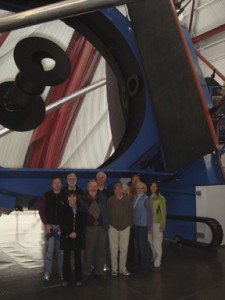
Secretary Clough (second from left in back row) and other members of the group in front of the Magellan telescope at Las Campanas.
As if on cue, the stage is set by nature. We leave our rooms to walk to the library and are stunned to walk into to a darkness that catches us by surprise. Fortunately, our hosts have provided us with small infrared devices to illuminate the path (white light is discouraged is it does not allow the viewer to see the stars). The darkness is enhanced by a moon that is only a sliver. Up in the night sky, stars and galaxies blaze with an intensity I have never experienced. Here, high on top of this mountain and without haze from a city, millions of stars evince themselves. Walking with us, Wendy calls our attention to the galaxies that can be seen, with their graceful swirling arms trailing a bright core. About all you can say at a time like this is “wow,” which seems unworthy of such a spectacle.
We arrive at the library and hear a stimulating lecture on dueling cosmological theories and the influence of dark energy. I’m not sure I’m ready to take a test on the subject, but the talk was enjoyable and informative. We leave the library for a bracing walk back to our room (the wind is up and the temperature has dropped). Along the way Andrea helps me understand more about the Smithsonian’s role in astronomy. Thus, a most interesting and worthwhile day comes to a close.
Day One, May 24. Santiago, Chile. Weather—cool, foggy (it is winter in Chile.)
I am traveling to Chile because of astronomy and astrophysics, related fields that form a pillar of Smithsonian science. This visit is about the future of Smithsonian astronomy and our role in the international collaboration to build one of the next generation of telescopes that will penetrate far into the heavens and create images even clearer than those obtained from the orbiting Hubble space telescope. I will be meeting with representatives from the Carnegie Institution for Science who operate existing telescopes high in the Andes to discuss the Smithsonian’s participation in the new project and to allow me, a non-astronomer, to see firsthand the work astronomers do. I have read books about Galileo and other heroic historical figures, but this visit will help me better appreciate the work of our modern-day scientists. I am fortunate to have along with me Andrea DuPree, one of the outstanding astronomers from the Smithsonian Astrophysical Observatory who works with the telescopes at our ultimate destination, the Las Campanas Observatory in the Chilean Andes.
We arrived in Santiago early Sunday morning. Founded by the Spanish conquistador Pedro de Valdivia in 1541, Santiago grew to become the capitol of Chile. De Valdvia, a lieutenant of Pizzaro, came to Chile looking for gold and silver and instead found a country rich in copper and agriculture. In the mid-twentieth century another wave of explorers was attracted to Chile, but the treasure they sought was to be found looking at the heavens. These were astronomers who came to build telescopes to gaze at the stars and ask fundamental questions about how the universe was formed. Why Chile? At an altitude of more 7,800 feet in the Andes, the air is clear and near-desert conditions provide low humidity, making conditions ideal for viewing the sky through a telescope.
Our astronomers have been regular users of the “Magellan” facility at Las Campanas, which consists of two 6.5-meter mirror telescopes that are said to capture the best images of any earth-based telescopes. That might sound pretty good, but the next generation of discoveries lie beyond the reach of today’s telescopes. The Smithsonian is part of the team that is working on a bold concept appropriately named the Giant Magellan Telescope, which will use seven 8.4-meter mirror segments. Construction of the GMT is a daunting endeavor, but one with the potential of a high payoff. The costs for the GMT are estimated to be $1.3 billion, so this is no small undertaking.
The Smithsonian’s role in astronomy and astrophysics dates back to the third Secretary of the Smithsonian, Samuel Pierpont Langley, who was internationally known for his work in astronomy and aerodynamics. During his tenure, 1887 to 1906, he founded the Smithsonian Astrophysical Observatory and built an observatory on the National Mall. The fifth Secretary, Charles Greeley Abbot, was also an astronomer who specialized in solar research. In time, the activities and facilities of SAO outgrew the original location behind the Smithsonian Castle and an agreement was struck with Harvard University to move SAO to Cambridge, Mass. Today, the Smithsonian-Harvard Astrophysical Observatory ranks among the best in the world; SI alone employs more than 300 scientists there. Despite SAO’s long history and international prominence, few of the 25 million people who visit Smithsonian museums each year know of our work in astronomy and astrophysics. We are going to work to change this.
Our landing in Santiago followed an overnight flight from Miami. As we drowsily proceed through customs to the baggage claim, Murphy’s Law strikes, and several members of our group, including my wife, Anne, do not find bags waiting. After leaving information about the missing bags with the authorities we are bused into downtown Santiago to our hotel. Following a short and welcome nap, a small group of us met for lunch. Lunch is no small matter in South America, and it is considered impolite to rush a meal. Kicking back from the rushed version of lunch in the U.S. is actually a good thing. Why rush when the food is good and the company fun? Helped us forget about the missing bags too.
After lunch we decide to take the metro (a very good one) to the Museo Chileno De Arte Precolombino. Our metro stop brought us to the city square, ringed by buildings of various ages, many of which date to the colonial period. People are everywhere, especially on the many benches beneath the royal palm trees. Their faces and stature speak to a story of mixed cultures and races. While native people and those of Spanish descent are the largest populations in Chile, the country also is home to significant numbers of other Europeans, including the Irish, who immigrated here, as well as to the United States, to escape the potato famine back home.
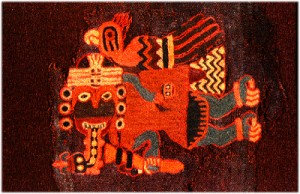
Cloth weaving was highly developed among pre-Columbian cultures such as the Paracas of Chile, which flourished 300-100 B.C.
The Museo turns out to be a delightful surprise with its outstanding exhibits of pre-Columbian artifacts. The pre-Columbian period dates back to at least 15,000 years ago as peoples from North American migrated down the coastlines of South America. The exhibits cover all of the identifiable cultures that developed from Mexico to Chile. In Chile, early people occupied different niches, from the rugged coastline to the desert-like high country in the Andean plateaus in the north of Chile. To the south, they occupied the more temperate and rainy lands found there.
In time, the settlers developed sophisticated cultures and about 6000 years ago, tools and household implements began to exhibit artistic design and decoration. Early stone painting appeared among the coastal Chinchorro peoples who created them to implore the gods to return the fish that periodically disappeared along the coast because of changing weather and current patterns caused by El Niño. Trade developed between the different groups and items from one region appeared in others. The level of sophistication of the art and design grew with time and new and more diverse materials were used. Colors become a stronger motif. The familiar bright colors of Indian textiles were once used to represent hierarchy in social standing. Although the various cultures intermingled, the different peoples have maintained to this day distinctive art and design that are unique to their history.
Viewing the beauty of the evolved works of peoples like the Nasca, the Inka and the Wari who lived in what is now Chile creates a sense of wonder. We are only beginning to develop an appreciation of these early civilizations. Fortunately, at the Smithsonian, the Museum of the American Indian has as its mission to tell these stories as well as those of the native people who made their homes in North America.
Upon leaving the Museo, Anne reminds me that since her bag has not arrived, she will need something warm to wear and she purchases a beautiful magenta wrap made by Chilean Indians. As they say, “one man’s misfortune is another’s good fortune,” and at least the Museo and the craftsperson have benefited.
Day one of our visit will close with a dinner with our traveling party. The good news is that, through the wonder of the Web, we learn that American Airlines has (in theory) found the missing bags. They should arrive on the morning flight from Miami and, with a touch of exceptional luck, will be at the airport in time for our flight up the coast to La Serena on our way to Las Campanas.
Posted: 27 May 2009
- Categories:
